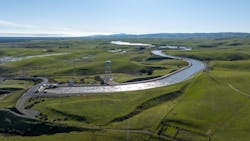California greatly increases State Water Project allocations
The California Department of Water Resources (DWR) announced a significant boost in forecasted State Water Project (SWP) deliveries this year, thanks to continued winter storms and a large Sierra snowpack.
DWR now expects to deliver 75% of requested water supplies, up from 35% announced in February. The increase translates to an additional 1.7 million acre-feet of water for the 29 public water agencies that serve 27 million Californians.
Consistent storms in late February and March have built up the Sierra snowpack to more than double the amount that California typically sees this time of year. Rainfall has also allowed for robust flows through the system, providing adequate water supply for the environment and endangered fish species while allowing SWP to pump the maximum amount of water allowed under state and federal permits into reservoir storage south of the Sacramento-San Joaquin Delta.
“California continues to experience weather whiplash, going from extreme drought to at least 19 atmospheric rivers since late December. It really demonstrates that in times of plenty, we need to move as much water into storage as is feasible,” said DWR Director Karla Nemeth. “We’ve been able to manage the system to the benefit of communities, agriculture and the environment. It’s certainly been a welcome improvement following the three driest years on record for California.”
Taking advantage of the extreme high flows in the system, the SWP is making additional water available to any contractor that has the ability to store the water in its own system, including through groundwater recharge. Formally known as Article 21 water, this water does not count toward formal SWP allocation amounts.
The SWP typically evaluates the allocation forecasts monthly using the latest snow survey data, reservoir storage and spring runoff forecasts. The latest 75 percent forecasted allocation takes into account that data from March.
DWR now expects San Luis Reservoir in Merced County to end the wet season at capacity. Lake Oroville, the State Water Project’s largest reservoir, is at 120 percent of average for this time of year and currently releasing water through the Oroville Spillway to reduce flood risk for downstream communities in anticipation of the spring snowmelt. The SWP will continue to optimize water storage in Lake Oroville to support environmental needs in the summer and allow for carryover storage for next year if dry conditions return.
While California’s surface water conditions have greatly improved this year following three years of historic drought, several water supply challenges remain in parts of the state.
The Colorado River Basin, which is a critical water supply source for Southern California, is still in the midst of a 23-year drought. Millions of Californians also rely on groundwater supplies as a sole source of water, and the state’s groundwater basins will be slow to recover following the extreme drought.
